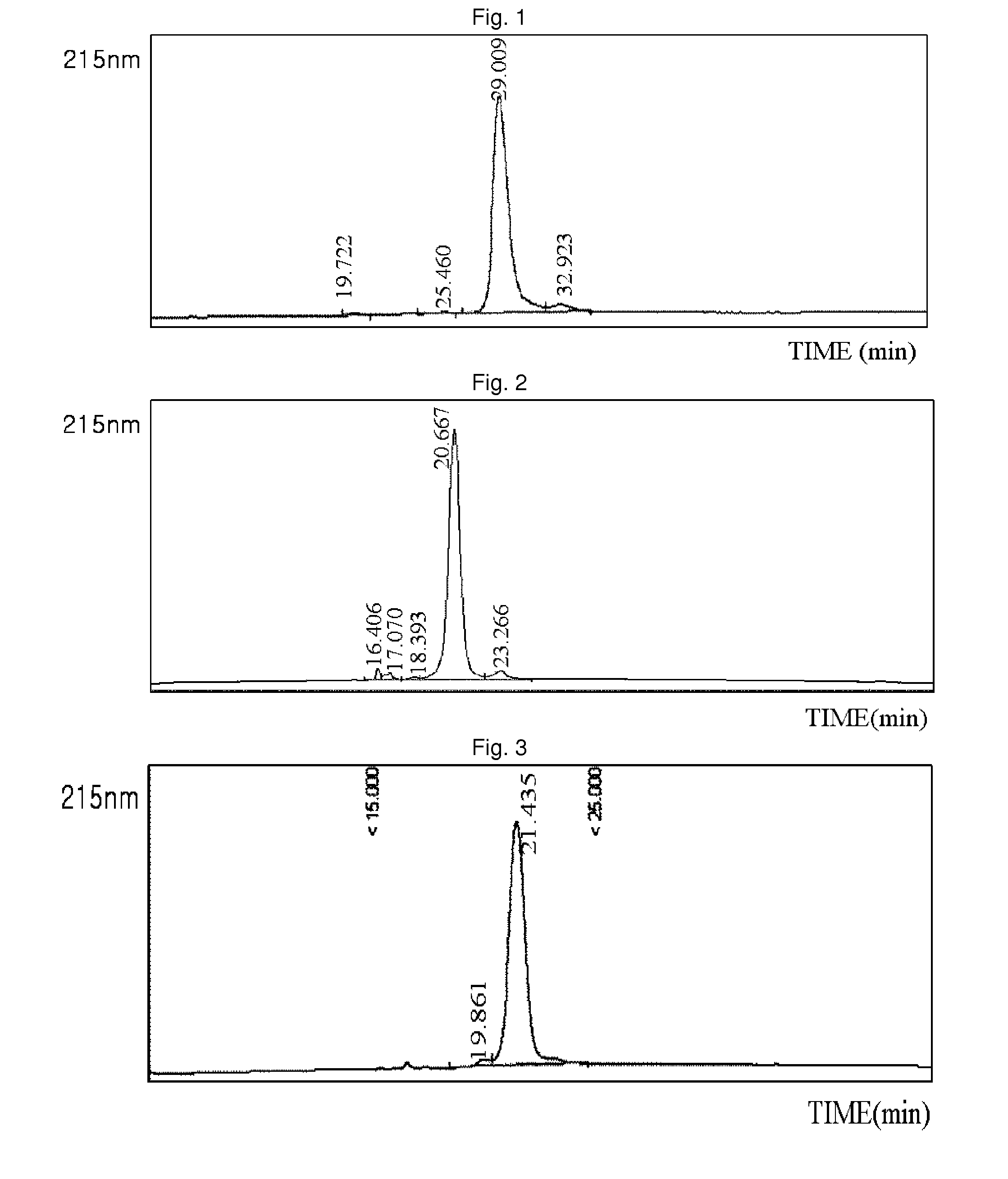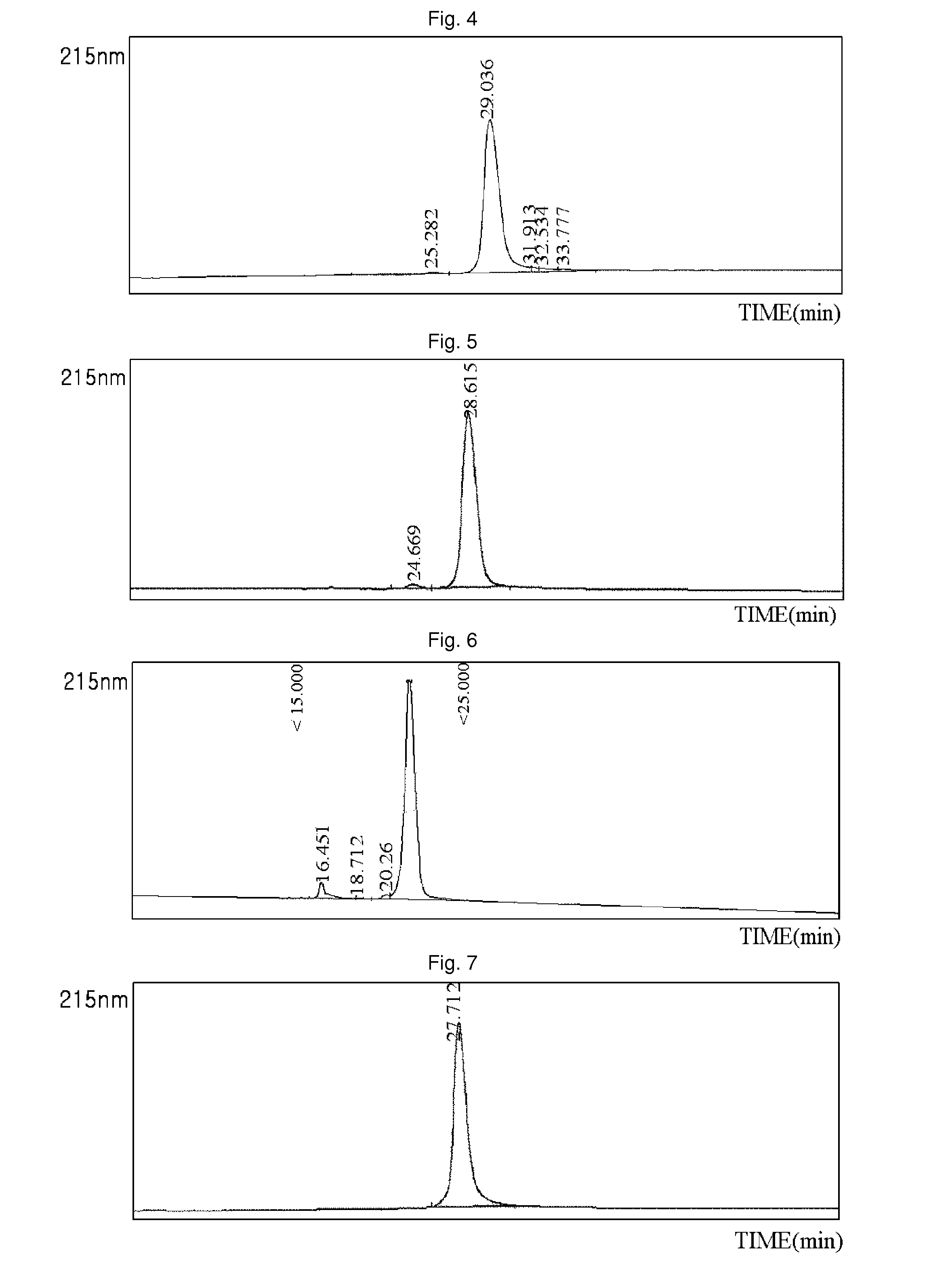Insulinotropic complex using an immunoglobulin fragment
a technology of immunoglobulin and complex, which is applied in the field of insulinotropic peptide conjugate, can solve the problems of easy denature, loss of activity, and small siz
- Summary
- Abstract
- Description
- Claims
- Application Information
AI Technical Summary
Benefits of technology
Problems solved by technology
Method used
Image
Examples
example 1
Pegylation of Exendin-4 and Isolation of Positional Isomer
[0087]3.4K PropionALD(2) PEG (PEG having two propionaldehyde groups, IDB Inc., South Korea) and the N-terminus of the exendin-4 (AP, USA) were subjected to pegylation by reacting the peptide and the PEG at 4° C. for 90 min at a molar ratio of 1:15, with a peptide concentration of 3 mg / ml. At this time, the reaction was performed in a NaOAc buffer at pH 4.0 at a concentration of 100 mM, and 20 mM SCB (NaCNBH3) as a reducing agent was added thereto to perform the reaction. 3.4K PropionALD(2) PEG and the lysine (Lys) residue of the exendin-4 were subjected to pegylation by reacting the peptide and the PEG at 4° C. for 3 hours at a molar ratio of 1:30, with a peptide concentration of 3 mg / ml. At this time, the reaction was performed in a Na-Phosphate buffer at pH 9.0 at a concentration of 100 mM, and 20 mM SCB as a reducing agent was added thereto to perform the reaction. A mono-pegylated peptide was purified from each of the rea...
example 2
Preparation of Exendin-4(N)-PEG-Immunoglobulin Fc Conjugate
[0088]Using the same method as described in EXAMPLE 1, 3.4K PropionALD(2) PEG and the N-terminus of the exendin-4 were reacted, and only the N-terminal isomers were purified, and then coupled with immunoglobulin Fc. The reaction was performed at a ratio of peptide:immunoglobulin Fc of 1:8, and a total concentration of proteins of 50 mg / ml at 4° C. for 17 hours. The reaction was performed in a solution of 100 mM K—P (pH 6.0), and 20 mM SCB as a reducing agent was added thereto. The coupling reaction solution was purified using two purification columns. First, SOURCE Q (XK 16 ml, Amersham Biosciences) was used to remove a large amount of immunoglobulin Fc which had not participated in the coupling reaction. Using 20 mM Tris (pH 7.5) and 1 M NaCl with salt gradients, the immunoglobulin Fc having relatively weak binding power was eluted earlier, and then the exendin-4-immunoglobulin Fc was eluted. Through this first purification...
example 3
Preparation of Exendin-4(Lys27)-PEG-Immunoglobulin Fc Conjugate
[0089]Using the same method as described in EXAMPLE 1, 3.4K PropionALD(2) PEG and the lysine (Lys) of the exendin-4 were reacted, and only the Lys isomers were purified, and then coupled with immunoglobulin Fc. Among the two isomer peaks, the last isomer peak (positional isomer of Lys27), which has more reaction and which is easily distinguishable from the N-terminal isomer peaks, was used for the coupling reaction. The reaction was performed at a ratio of peptide:immunoglobulin Fc of 1:8, and a total concentration of proteins of 50 mg / ml at 4° C. for 16 hours. The reaction was performed in a solution of 100 mM K—P (pH 6.0), and 20 mM SCB was added as a reducing agent. After the coupling reaction, the two-step purification process using SOURCE Q 16 ml and SOURCE ISO 16 ml was the same as in EXAMPLE 2. The purity measured by reverse phase HPLC was 91.7%. (FIG. 2)
PUM
| Property | Measurement | Unit |
|---|---|---|
| pH | aaaaa | aaaaa |
| pH | aaaaa | aaaaa |
| molecular weight | aaaaa | aaaaa |
Abstract
Description
Claims
Application Information
 Login to View More
Login to View More - R&D
- Intellectual Property
- Life Sciences
- Materials
- Tech Scout
- Unparalleled Data Quality
- Higher Quality Content
- 60% Fewer Hallucinations
Browse by: Latest US Patents, China's latest patents, Technical Efficacy Thesaurus, Application Domain, Technology Topic, Popular Technical Reports.
© 2025 PatSnap. All rights reserved.Legal|Privacy policy|Modern Slavery Act Transparency Statement|Sitemap|About US| Contact US: help@patsnap.com



